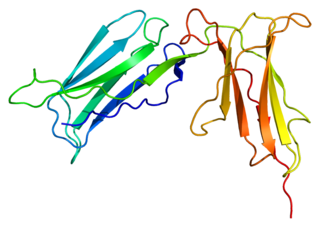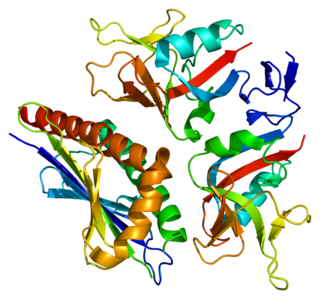Related Research Articles

The Cluster of differentiation 80 is a B7, type I membrane protein in the immunoglobulin superfamily, with an extracellular immunoglobulin constant-like domain and a variable-like domain required for receptor binding. It is closely related to CD86, another B7 protein (B7-2), and often works in tandem. Both CD80 and CD86 interact with costimulatory receptors CD28, CTLA-4 (CD152) and the p75 neurotrophin receptor.

CD94, also known as killer cell lectin-like receptor subfamily D, member 1 (KLRD1) is a human gene.

CD5 is a cluster of differentiation expressed on the surface of T cells and in a subset of murine B cells known as B-1a. The expression of this receptor in human B cells has been a controversial topic and to date there is no consensus regarding the role of this receptor as a marker of human B cells. B-1 cells have limited diversity of their B-cell receptor due to their lack of the enzyme terminal deoxynucleotidyl transferase (TdT) and are potentially self-reactive. CD5 serves to mitigate activating signals from the BCR so that the B-1 cells can only be activated by very strong stimuli and not by normal tissue proteins. CD5 was used as a T-cell marker until monoclonal antibodies against CD3 were developed.

Leukocyte immunoglobulin-like receptor subfamily B member 1 is a protein that in humans is encoded by the LILRB1 gene.

Killer cell immunoglobulin-like receptor 3DL1 is a protein that in humans is encoded by the KIR3DL1 gene.

Killer cell immunoglobulin-like receptor 2DL4 is a protein that in humans is encoded by the KIR2DL4 gene.

Decoy receptor 3 (Dcr3), also known as tumor necrosis factor receptor superfamily member 6B (TNFRSF6B), TR6 and M68, is a soluble protein of the tumor necrosis factor receptor superfamily which inhibits Fas ligand-induced apoptosis.

Decoy receptor 2 (DCR2), also known as TRAIL receptor 4 (TRAILR4) and tumor necrosis factor receptor superfamily member 10D (TNFRSF10D), is a human cell surface receptor of the TNF-receptor superfamily.

NKG2-F type II integral membrane protein is a protein that in humans is encoded by the KLRC4 gene.

Killer cell immunoglobulin-like receptor 3DL2 is a protein that in humans is encoded by the KIR3DL2 gene.

Killer cell lectin-like receptor subfamily B, member 1, also known as KLRB1, NKR-P1A or CD161, is a human gene.

Killer cell immunoglobulin-like receptor 2DS4 is a protein that in humans is encoded by the KIR2DS4 gene.

NKG2-C type II integral membrane protein or NKG2C is a protein that in humans is encoded by the KLRC2 gene. It is also known as or cluster of differentiation 159c (CD159c).

UL16 binding protein 2 (ULBP2) is a cell surface glycoprotein encoded by ULBP2 gene located on the chromosome 6. ULBP2 is related to MHC class I molecules, but its gene maps outside the MHC locus. The domain structure of ULBP2 differs significantly from those of conventional MHC class I molecules. It does not contain the α3 domain and the transmembrane segment. ULBP2 is thus composed of only the α1α2 domain which is linked to the cell membrane by the GPI anchor.

UL16 binding protein 1 (ULBP1) is a cell surface glycoprotein encoded by ULBP1 gene located on the chromosome 6. ULBP1 is related to MHC class I molecules, but its gene maps outside the MHC locus. The domain structure of ULBP1 differs significantly from those of conventional MHC class I molecules. It does not contain the α3 domain and the transmembrane segment. ULBP1 is thus composed of only the α1α2 domain which is linked to the cell membrane by the GPI anchor. It functions as a stress-induced ligand for NKG2D receptor. ULBP1 is, for example, upregulated during HCMV infection. Binding of HCMV-encoded UL16 glycoprotein to ULBP1 interferes with cell surface localization of ULBP1; this represents another mechanism by which HCMV-infected cells might escape the immune system.

C-type lectin domain family 2 member D is a protein that in humans is encoded by the CLEC2D gene.

UL16 binding protein 3 (ULBP3) is a cell surface glycoprotein encoded by ULBP3 gene located on the chromosome 6. ULBP3 is related to MHC class I molecules, but its gene maps outside the MHC locus. The domain structure of ULBP3 differs significantly from those of conventional MHC class I molecules. It does not contain the α3 domain and the transmembrane segment. ULBP3 is thus composed of only the α1α2 domain which is linked to the cell membrane by the GPI anchor. It functions as a stress-induced ligand for NKG2D receptor.

NKG2D is an activating receptor (transmembrane protein) belonging to the NKG2 family of C-type lectin-like receptors. NKG2D is encoded by KLRK1 (killer cell lectin like receptor K1) gene which is located in the NK-gene complex (NKC) situated on chromosome 6 in mice and chromosome 12 in humans. In mice, it is expressed by NK cells, NK1.1+ T cells, γδ T cells, activated CD8+ αβ T cells and activated macrophages. In humans, it is expressed by NK cells, γδ T cells and CD8+ αβ T cells. NKG2D recognizes induced-self proteins from MIC and RAET1/ULBP families which appear on the surface of stressed, malignant transformed, and infected cells.
Murine UL16 binding protein-like transcript (MULT-1) is a murine cell surface glycoprotein encoded by MULT-1 gene located on murine chromosome 10. MULT-1 is related to MHC class I and is composed of α1α2 domain, a transmembrane segment, and a large cytoplasmic domain. MULT-1 functions as a stress-induced ligand for NKG2D receptor.
Retinoic acid early inducible 1 (RAE-1) family of murine cell surface glycoproteins is composed of at least five members (RAE-1α-ε). Genes encoding these proteins are located on mouse chromosome 10. RAE-1 proteins are related to MHC class I, they are made up of external α1α2 domain which is linked to the cell membrane by the GPI anchor. They function as stress-induced ligands for NKG2D receptor and their expression is low or absent on normal cells. However, they are constitutively expressed on some tumour cells and they can be upregulated by retinoic acid.
References
- ↑ Malarkannan, Subramaniam (1998). "The molecular and functional characterization of a dominant minor H antigen, H60". J. Immunol. 161 (7): 3501–9. doi: 10.4049/jimmunol.161.7.3501 . PMID 9759870. S2CID 2202196.
- 1 2 3 4 5 Takada, Akio; Yoshida, Shigeru; Kajikawa, Mizuho; Miyatake, Yukiko; Tomaru, Utano; Sakai, Masaharu; Chiba, Hitoshi; Maenaka, Katsumi; Kohda, Daisuke (2008-02-01). "Two Novel NKG2D Ligands of the Mouse H60 Family with Differential Expression Patterns and Binding Affinities to NKG2D". The Journal of Immunology. 180 (3): 1678–1685. doi: 10.4049/jimmunol.180.3.1678 . ISSN 0022-1767. PMID 18209064.
- 1 2 3 Cerwenka, Adelheid; Bakker, Alexander B. H.; McClanahan, Terri; Wagner, Janet; Wu, Jun; Phillips, Joseph H.; Lanier, Lewis L. (2000-01-06). "Retinoic Acid Early Inducible Genes Define a Ligand Family for the Activating NKG2D Receptor in Mice". Immunity. 12 (6): 721–727. doi: 10.1016/S1074-7613(00)80222-8 . ISSN 1074-7613. PMID 10894171.